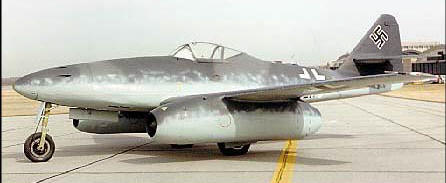



Messerschmitt 262 "Schwalbe"

|
Developed from a 1938 design by the Messerschmitt company, the Me 262 "Schwalbe," ("Swallow") was the world's first operational turbojet aircraft. First flown as a pure jet on July 18, 1942, it proved much faster than conventional airplanes. Development problems, Allied bombings, and cautious Luftwaffe leadership contributed to delays in quantity production. In late 1943, Adolf Hitler agreed to mass production, but insisted the aircraft be used primarily as a fighter-bomber. On July 25, 1944, an Me 262 became the first jet airplane used in combat when it attacked a British photo-reconnaissance Mosquito flying over Munich. As a fighter, the German jet scored heavily against allied bomber formations. The bombers, however, destroyed hundreds of Me 262s on the ground. More than 1,400 Me 262s were produced, but fewer than 300 saw combat. Most remained on the ground awaiting conversion to bombers, or were unable to fly because of lack of fuel, spare parts, or trained pilots. The Me 262A above was brought to the U.S. from Germany in July 1945 for flight evaluation. It was restored by the 96th Mobile Maintenance Squadron, Kelly AFB, Texas in 1976-79, and is finished in the standard production paint scheme, without operational unit markings.
SPECIFICATIONS
PERFORMANCE
OPERATION "LUSTY" During WWII, the U.S. Army Air Forces (USAAF) Intelligence Service sent teams to Europe to gain access to enemy aircraft, technical and scientific reports, research facilities, and weapons for study in the US The Air Technical Intelligence (ATI) teams, trained at the Technical Intelligence School at Wright Field, Ohio, collected enemy equipment to learn about Germany’s technical developments. The ATI teams competed with 32 allied technical intelligence groups to gain information and equipment recovered from crash sites. As the war concluded, the various intelligence teams, including the ATI, shifted from tactical intelligence to post hostilities investigations. Exploitation intelligence increased dramatically. On April 22, 1945, the USAAF combined technical and post-hostilities intelligence objectives under the Exploitation Division with the code name LUSTY. Operation LUSTY began with the aim of exploiting captured German scientific documents, research facilities, and aircraft. The Operation had two teams. One, under the leadership of Colonel Harold E. Watson, a former Wright Field test pilot, collected enemy aircraft and weapons for further examination in the US The other recruited scientists, collected documents, and investigated facilities. Having been part of ATI in 1944, Colonel Watson eagerly accepted the Operation LUSTY assignment.
WATSON'S "WHIZZERS"
After the war, the "Whizzers" added Luftwaffe test pilots to their team. One was Hauptman Heinz Braur. On May 8, 1945, Braur flew 70 women, children, and wounded troops to Munich-Riem airport. After he landed, Braur was approached by one of Watson's men who gave him the choice of either going to a prison camp or flying with the "Whizzers." Braur thought flying more preferable. Three Messerschmitt employees also joined the "Whizzers:" Karl Baur, the Chief Test Pilot of Experimental Aircraft; test pilot Ludwig "Willie" Huffman; and engineering superintendent, Gerhard Coulis. Test pilot Herman Kersting joined later. When the "Whizzers" located nine Me 262 jet aircraft at Lechfeld airfield, these German test pilots had the expertise to fly them. Watson's men traveled far and wide over Europe by jeep and occasionally by air to find the aircraft on the "Black Lists." Once found, they had to be shipped to the US Fortunately, the British were willing to loan the aircraft carrier HMS Reaper. The most viable harbor for docking the carrier and loading the various aircraft was at Cherbourg, France. The "Whizzers" flew the Me 262s and other aircraft from Lechfeld to St. Dizier, to Melun, and then to Cherbourg. All the aircraft were cocooned against the salt air and weather, loaded onto the carrier, and brought to the US where they were studied by the Air Intelligence groups of both the USAAF and Navy.
DISPOSITION OF FOREIGN EQUIPMENT In 1945, the enemy aircraft shipped to the US were divided between the Navy and the Army Air Forces. General Hap Arnold ordered the preservation of one of every type of aircraft used by the enemy forces. The Air Force brought their aircraft to Wright Field, and when the field could no longer handle additional aircraft, many were sent to Freeman Field, Seymour, Indiana. In the end, Operation LUSTY collectors had acquired 16,280 items (6,200 tons) to be examined by intelligence personnel who selected 2,398 separate items for technical analysis. Forty-seven personnel were engaged in the identification, inspection, and warehousing of captured foreign equipment. In 1946, when Freeman Field was scheduled to close, Air Technical Service Command (ATSC) had to move the aircraft. The larger aircraft were sent to Davis-Monthan Field, Tucson, Arizona, and the fighter aircraft sent to the Special Depot, Park Ridge, Illinois (now O'hare airport) which was under the control of ATSC's Office of Intelligence. The Special Depot occupied buildings that Douglas Airplane Company had used to build C-54 aircraft. The aircraft were stored in these two locations until they could be disposed of in accordance with General Arnold's order. With the start of the Korean War in 1950, the Air Force needed the Special Depot; so the air-craft had to be moved outside. In 1953, some of the aircraft were moved to the National Air and Space Museum in Silver Hill, Maryland, and the remaining aircraft were scrapped. |